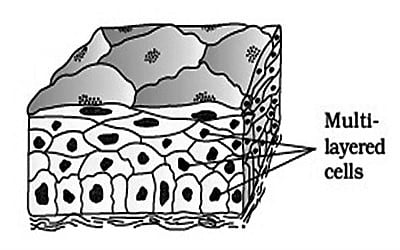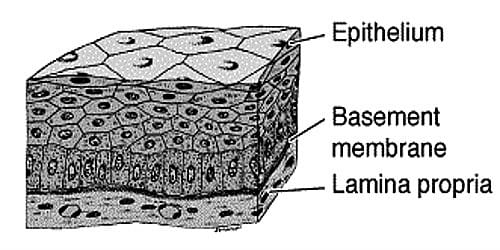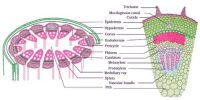The compound epithelium is made of more than one layer (multi-layered) of cells and thus has a limited role in secretion and absorption (Figure). Their main function is to provide protection against chemical and mechanical stresses. They cover the dry surface of the skin, the moist surface of the buccal cavity, pharynx, inner lining of ducts of salivary glands and of pancreatic ducts. These tissues are widespread throughout the body.

Compound epithelium tissue is shaped of numerous layers of epithelial cells of dissimilar shapes representing newly shaped and mature cells. This tissue forms the covering of all body surfaces and they are the major tissue in glands. The superficial layer grows outward from below. Basement membranes are generally absent. Their major function is to defend underlying formation from mechanical wear and tear.
- The compound epithelium has a lot of layers thick and it is present in the lining of the pharynx and buccal cavity.
- In compound epithelia, the cells of dissimilar layers demonstrate differences in their size and shape.
- This tissue covers surfaces subjected to deep wear and tear and this tissue can supply much-enhanced shield to the fundamental structures.
- This tissue has only very tiny or no function in the absorption, secretion, and emission.
All cells in the epithelium are held together with little intercellular material. In nearly all animal tissues, specialized junctions provide both structural and functional links between its individual cells. Three types of cell junctions are found in the epithelium and other tissues. These are called as tight, adhering and gap junctions. Tight junctions help to stop substances from leaking across a tissue. Adhering junctions perform cementing to keep neighboring cells together. Gap junctions facilitate the cells to communicate with each other by connecting the cytoplasm of adjoining cells, for rapid transfer of ions, small molecules, and sometimes big molecules.
Compound or Stratified epithelium Types:
- Stratified squamous epithelium
- Stratified cuboidal epithelium
- Stratified columnar epithelium
- Transitional epithelium
(1) Stratified squamous epithelium
The stratified squamous epithelium consists of numerous layers, with squamous cells at the apical surface. The main purpose of this type of epithelium is a fortification.
(2) Stratified cuboidal epithelium:
The stratified cuboidal epithelium consists of a manifold layer of the cell where the furthest layer of cells is cuboidal in shape. Found in the conjunctiva of eyes, inside layer of ducts of sweat glands, salivary gland, mammary glands, etc.
Major Function – fortification against perfunctory and chemical pressure.
(3) Stratified Columnar epithelium:
The stratified columnar epithelium consists of several layers of cells where the farthest layer of cells are columnar in form, Middle layer is cuboidal. It forms an inside layer of vasa-differentia, respiratory tract and mammary gland.
Main functions are secretion of fluids and fortification from motorized and chemical anxiety.
(4) Transitional epithelium:
The transitional epithelium consists of layers of cells which are comparable in size and might be trampled at the top and have the ability to transform nature. Found in areas that are subjected to strain situation such as – urinary bladder, ureter, and renal pelvis.
Major Function – development of the organ, avert loss of water form blood and avert flee of urine to adjacent tissue.












